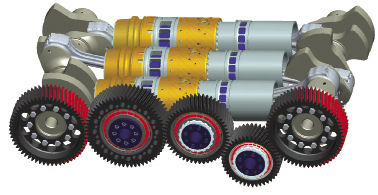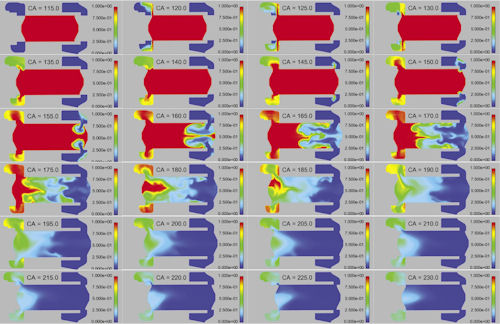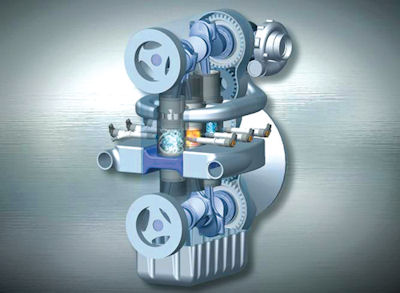Latest News
August 1, 2013
 |
Dubbed “An Engine That Uses One-Third Less Fuel” in MIT Technology Review (Jan. 14, 2013, TechnologyReview.com), Achates’ engine bypasses the need for cylinder heads, “which are a major contributor to heat losses in conventional engines,” according to the company. The OPE contains two pistons per cylinder, working in opposite reciprocating action. In a paper authored by Achates’ staff, the company states that its opposed-piston, two-stroke diesel engine design “provides a step-function improvement in brake thermal efficiency compared to conventional engines while meeting the most stringent, mandated emissions requirements.”
That significant advantage is one the reasons the trucking industry has been quick to adopt it. Other sectors deploying the same technology include military (for tanks), aerospace and marine (“Eight Companies Determined to Change Diesel Engines Forever,” March 2012, Diesel Power, DieselPowerMag.com). Whereas Achates’ clients rely on the company’s OPE technology, Achates relies on CONVERGE Computational Fluid Dynamics (CFD), computer-aid flow simulation software, to study and perfect its engine design.
The Chemistry of Combustion
In the software the company was previously using, and in many other commercial codes available, using a combustion model including detailed chemical kinetic mechanisms wasn’t an option, noted Rishikesh Venugopal, Achates’ senior staff engineer. “CONVERGE is one of the earliest adopters of detailed chemistry,” he adds. “It took too much time to simulate with detailed chemistry ]in other software]. CONVERGE uses an automatic adaptive meshing technique, which lets us use not only detailed chemistry, but also reduces computing time.”
Observing detailed chemical reactions in engine operations is important for Achates because the company is “not only trying to optimize engine performance but also emissions,” says Venugopal. “Studying detailed chemistry reactions lets us understand, for instance, the oxidation of fuel through several reaction steps. If the chemistry is not detailed, then we can’t capture the sensitivity of the emissions, such as nitrogen oxides and soot, when the engine’s operating conditions change.”
Adaptive Meshing
The simulation usually begins with a Pro/ENGINEER CAD model, converted into .STL format. Other than fixing a few triangulation problems that occur during the conversion process, Achates engineers seldom do any other additional work on the .STL model.
“We refined the process of developing the Pro/E model to make the .STL implementation into CONVERGE software easy,” explains Redon. “It has taken us some time to refine that process to understand the characteristics of the Pro/E model we can readily use when converting to .STL.”
“With CONVERGE, we don’t need to clean up the .STL model as much as in other software,” adds Rodrigo Zerme ±o, Achates’ development engineer. “The automatic mesher takes care of the small features ]details such as rounded corners, small holes and fasteners not needed for simulation].”
 To study the best possible configuration of its engine, Achates uses CONVERGE CFD software. |
The adaptive mesher also makes the job easier by automatically using an appropriate degree of details for each region of the model. The software doesn’t blindly apply fine meshes on the entire model, explains Venugopal. This method keeps the number of elements as low as possible, thus reducing computing time during simulation.
Known and Unknown
From experience and years of R&D, Achates has developed fairly accurate engine combustion data, such as the inside temperature of the engine walls—critical for calculating heat transfer in digital simulation. For the rest of the data needed for simulation, engineering judgment has to be used, Venugopal says.
“Take, for instance, the spray characteristics,” Venugopal continues. “It requires very detailed breakup time-scale and droplet-dynamics related constants, which cannot easily be measured.” For those, Achates relies on real-world tests conducted with fuel injectors in its state-of-the-art fuel lab to obtain the right approximations. “Physical lab tests guiding simulation” is the only way to remove uncertainties, Venugopal says.
Finding the Best Way to Combust
The purpose of simulating the engine is to “optimize combustion,” Redon says. “We have so many combinations we can lay out our engine. So it’s critical to use simulation tools to study the options we have.”
During simulation of the engine scavenging process, Achates encountered a scenario the software couldn’t faithfully replicate. The OPE has two sets of ports: one set for exhaust, another set for the intake.
“In an opposed-piston two-stroke diesel engine, the areas of the ports change as the pistons move past them, and this is a geometric feature that CONVERGE initially couldn’t capture,” explains Redon.
As robust as the software is, “when you have very thin regions with high-pressure flows, it’s difficult to simulate the event in a mathematically stable manner,” Venugopal says. So, in collaboration with CONVERGE, Achates engineers came up with a workaround. They shrank the pistons’ diameter by 0.1% and added a thin layer of cells—called liner gaps—between the ports and the pistons. This allowed the fluid motion to occur.
“Using the disconnect triangle feature ]in the software] and the liner gaps, we were able to simulate where the flow was occurring and where it was blocked when the ports were uncovered by the pistons,” says Venugopal. “That was significant because we were able to observe the gas exchange happening in the open-cycle scavenging.”
The workaround didn’t compromise the fidelity of the simulation, but it did require diligent monitoring of the process, notes Venugopal. “We had to use two sets of geometry—with liner gaps, and without. So we couldn’t run the entire scavenging cycle as one cycle. We split it into two simulations,” he said. “We had to use good bookkeeping to make sure we were using the right geometry for the right phase.”
This workaround is no longer needed because CONVERGE CFD now has a sealing feature that resolves the issue, according to Rob Kaczmarek, director of sales and marketing, CONVERGE.
Injection Innovation
The use of optimization driven by CONVERGE software’s genetic algorithm (GA) has allowed Achates to find the best configuration of injectors, among others.
“Even though the solution was what we anticipated and it made sense, we also saw how far we could push it,” Venugopal reflects. “It also showed that, even as we were pushing the design’s limits, the engine was still giving good performance.”
In keeping with its biological metaphor, the GA optimization begins with a set number of design options, and then spawn a greater number by varying different parameters.
“In one such GA run, I believe we ran about 200 to 300 designs before arriving at the desired solution,” Venugopal recalls. “But the software wasn’t running all ]parameter] combinations at all times; it was only running those that were favorable, so it didn’t waste time.”
Achates uses a Linux cluster and Windows cluster to run the software. For optimization jobs, Achates relies on the Linux cluster because, Venugopal explained, the code is deeply rooted in the Linux environment, as it’s often the case with combustion CFD codes. At Achates, a typical combustion simulation involves 100,000 to 200,000 elements, running on eight to 16 CPU cores. In larger jobs, it could involve a few million cells, running on 32 cores. The jobs can take anywhere from eight hours to five days.
“CONVERGE possesses extensive technologies to minimize the runtimes on high-performance computing platforms,” says Kaczmarek. The company is also working with Lawrence Livermore National Laboratory, Cummins Inc., Indiana University and NVIDIA, and will be releasing CONVERGE with GPU support later this year, he adds.
 The design of Achates’ opposed-piston engine in a rendered 3D model. |
“Keep in mind that, after a certain number of cores, the performance benefits are no longer proportional to the number of cores you add because there’ll be increased chatter,” notes Venugopal, referring to communication between cores. “So it’s really about balancing the number of licenses you have, the cores, and the job. We tried to take into account all these factors.”
CONVERGE CFD’s licensing policy is multicore-friendly, he says.
Reality and Simulation
“Our engine technology is much more complicated than conventional engines, so some of our strategies cannot be applied blindly,” says Achates’ Redon. “It’s very important to anchor simulation in physical tests.”
CONVERGE’s Kaczmarek agrees: “While it’s our goal to provide our customers with the most advanced CFD tools on the market, it’s important to remember that simulation and validation must always coexist.”
As the use of simulation gains popularity, there’s a risk that designers might place unwarranted trust in simulation results. Achates’ philosophy—always make sure simulation stays close to the physical response of the engine—serves as a good reminder not to lose touch with reality.
Kenneth Wong is Desktop Engineering’s resident blogger and senior editor. Email him at [email protected] or share your thoughts on this article at deskeng.com/facebook.
More Info
Subscribe to our FREE magazine, FREE email newsletters or both!
Latest News
About the Author
Kenneth Wong is Digital Engineering’s resident blogger and senior editor. Email him at [email protected] or share your thoughts on this article at digitaleng.news/facebook.
Follow DE





